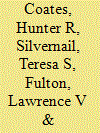| Srl | Item |
| 1 |
ID:
101323


|
|
|
|
|
| Publication |
2010.
|
| Summary/Abstract |
The United States Army recently implemented a policy aimed at quelling a large-scale exodus of captains. This policy included the provision of a Menu of Incentives Program targeting officers in year groups 1999-2005. This study details the captain attrition problem, evaluates literature regarding retention options, analyzes the efficacy of the Army's interventions by branch and by year group, and draws conclusions regarding future incentives. Methods used include chi-square and odds ratios analysis. Results reflect high acceptance rates for year groups 1999-2003; however, officers in these year groups may have remained in the service without any additional incentives because they were logically beyond the initial decision point. Findings suggest that seniority, skill, and adequate incentive pay are important considerations for future incentive programs.
|
|
|
|
|
|
|
|
|
|
|
|
|
|
|
|
| 2 |
ID:
114030


|
|
|
|
|
| Publication |
2012.
|
| Summary/Abstract |
The current military assignment policy of United States prohibits the assignment of females to billets with high risk of combat exposure. As part of an Army review of this policy, the authors analyzed deployment and promotion risk for combat medics. The effect of current policy on male deployment and female promotion risk was unknown. In light of other countries' policies and current operational considerations, senior military leaders sought to understand the effects of existing policy on a low-density, high-value occupational specialty, the combat medic. The authors found evidence that male medics deployed 2.07 times more frequently than female medics. The authors also found evidence that senior male medics (staff sergeants) deployed even more frequently (3.65-1) than their female counterparts. Perhaps as a result, the male combat medics experience higher likelihood of promotion from staff sergeant (E-6) to the rank of sergeant first class (E-7); however, the magnitude of that benefit was about one-third of the deployment risk. The results confirm the existence of gender-based deployment risk and promotion disparity. Based upon this analysis, the authors recommended the deprecation of current gender coding for combat medics to the senior levels of the US Army.
|
|
|
|
|
|
|
|
|
|
|
|
|
|
|
|